Trigger Point Therapy for Myofascial Pain (17 page)
Read Trigger Point Therapy for Myofascial Pain Online
Authors: L.M.T. L.Ac. Donna Finando

Repeat eight to ten times, increasing repetitions as the strength of the muscle allows. Do not allow the torso to move during the course of the exercise.
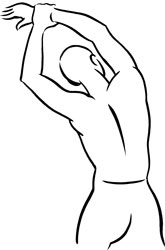
Stretch exercise: Latissimus dorsi
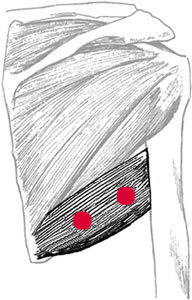
Teres major and trigger points
T
ERES
M
AJOR
Proximal attachment:
Teres major fuses with latissimus dorsi to attach at the medial edge of the bicipital groove, on the anterior aspect of the humerus.
Distal attachment:
Inferior angle of the scapula.
Action:
Internal rotation, adduction, and extension of the arm.
Palpation:
Teres major and latissimus dorsi are fused at their insertion into the bicipital groove. The tendon of latissimus dorsi twists upon itself before fusing with teres major at the attachment at the bicipital groove.
To locate teres major, identify the following structures:
- Inferior angle of the scapulaâThe sharp, triangular, distal aspect of the scapula. In most cases the inferior angle of the scapula lies on a horizontal line with T7.
- Bicipital groove of the humerus (intertubercular groove)âIdentify the greater and lesser tuberosities of the humerus, just distal to the lateral aspect of the acromion. (These are best palpated with the arm externally rotated.) The bicipital groove lies medial to the greater tuberosity and lateral to the lesser tuberosity. Note that the tendon of the long head of the biceps brachii runs through the bicipital groove.
Palpate teres major at the posterior axillary fold, deeper and more medial than latissimus dorsi. Taut bands or trigger points within teres major will be found proximal to the midpoint of the lateral edge of the scapula.
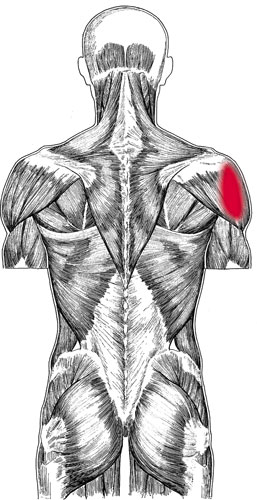
Teres major pain pattern
Pain pattern:
Pain is referred to the posterior deltoid region. Pain may extend to the extensor surface of the forearm. Patient has difficulty abducting the arm and placing it against the homolateral ear. Pain is experienced when reaching forward and up, and there is little restriction of motion.
Causative or perpetuating factors:
Depressor movements that overload, as in pulling something down from above or holding a heavy, bulky object.
Satellite trigger points:
Long head of the triceps brachii, latissimus dorsi, posterior deltoid, teres minor, subscapularis.
Affected organ system:
Digestive system.
Associated zones, meridians, and points:
Dorsal zone; Hand Tai Yang Small Intestine meridian; SI 9.
Stretch exercises:
- Reach both arms above the head. Grasp the wrist of the hand on the affected side with the opposite hand. Pull the wrist and arm toward the unaffected side, bending the torso to that side. Hold this position for a count of ten to fifteen.
- Stand, or lie supine, with the elbow of the affected side close to the ear, forearm behind the head. Pull the elbow toward the opposite side.
Strengthening exercise:
Standing with the legs shoulder-width apart, bend from the waist so the upper body is parallel to the floor. Reach the arm of the affected side toward the opposite foot. Bend the elbow to make a 90-degree angle and retract the scapula, extending the upper arm, bringing it to a position alongside the torso. The final position is one in which both the torso and the upper arm are parallel to the floor, while the forearm is perpendicular to the floor. Draw the arm to the side to a count of two. Reach for the opposite foot to a count of four.
Repeat eight to ten times, increasing repetitions as the strength of the muscle allows. Do not allow the torso to move during the course of the exercise.
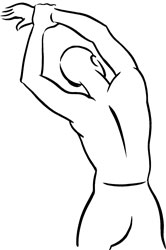
Stretch exercise 1:Teres major
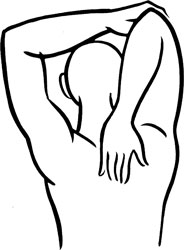
Stretch exercise 2:Teres major
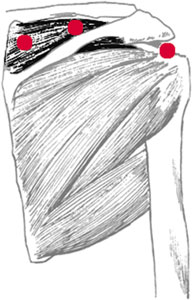
Supraspinatus and trigger points
S
UPRASPINATUS
Proximal attachment:
Supraspinatus fossa of the scapula.
Distal attachment:
Upper part of the greater tubercle of the humerus.
Action:
Assists the deltoid in abduction of the humerus by pulling the head of the humerus inward toward the glenoid fossa. Aids in stabilizing the head of the humerus in the glenoid fossa.
Palpation:
Supraspinatus is one of the four muscles that comprise the rotator cuff. The other muscles of the rotator cuff are infraspinatus, teres minor, and subscapularis. Supraspinatus lies deep to the trapezius.
To locate supraspinatus, identify the following structures:
- Supraspinatus fossa of the scapulaâThe dorsal aspect of the scapula lying proximal to the spine of the scapula.
- AcromionâThe flat, lateral aspect of the scapula at the most lateral tip of the shoulder girdle. Abducting the humerus as you palpate the lateral tip of the shoulder girdle, you can clearly distinguish between the rectangular acromion and the head of the humerus.
To palpate supraspinatus, palpate deep to the trapezius in the supraspinatus fossa, moving laterally toward the acromion. Trigger points and areas of constriction most commonly can be palpated approximately 1 inch lateral to the medial (vertebral) border of the scapula just superior to the spine of the scapula and just medial to the acromion, between the clavicle and the spine of the scapula. Deep palpation is required to feel through the trapezius muscle; however, care should be taken to avoid forcing through constricted muscle in an effort to reach an underlying muscle.
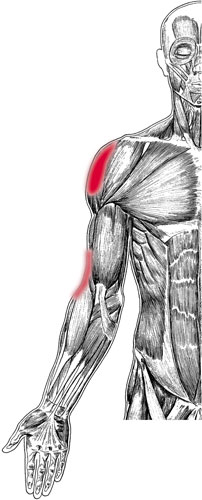
Supraspinatus (anterior) pain pattern
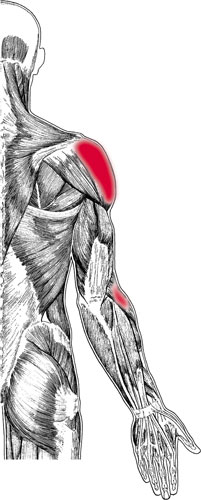
Supraspinatus (posterior) pain pattern
Pain pattern:
Pain concentrates in the middle deltoid region and is experienced as a deep ache when the arm is at rest. The ache extends downward over the arm and forearm and sometimes focuses over the lateral epicondyle. Pain is commonly felt during abduction.
Causative or perpetuating factors:
Carrying heavy objects with the arm hanging at the side.
Satellite trigger points:
Subscapularis, infraspinatus, middle trapezius, upper trapezius, deltoid, latissimus dorsi.
Affected organ systems:
Respiratory and digestive systems.
Associated zones, meridians, and points:
Dorsal zone; Hand Yang Ming Colon meridian, Hand Tai Yang Small Intestine meridian, Hand Shao Yang Triple Warmer meridian; CO 16, SI 12, TW 14 and 15.
